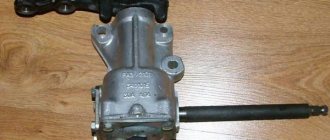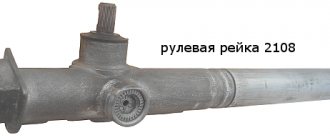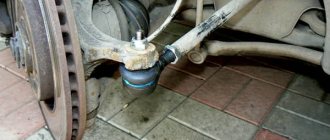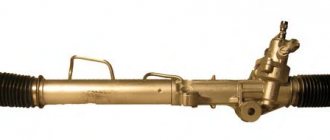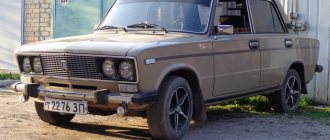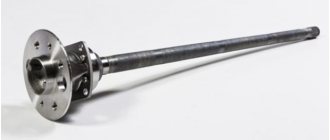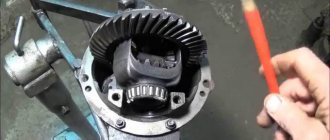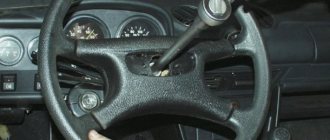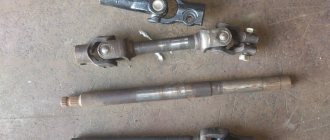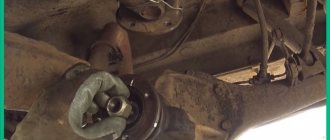Steering is present in all cars, regardless of class and year of manufacture. The device must always be in good condition and any changes to it are prohibited. The VAZ 2107 and other classic Zhiguli models are equipped with a worm-type steering column, which requires periodic inspection and sometimes repair.
- Steering gearbox design
Signs of gearbox malfunction - Table: VAZ 2107 steering faults and ways to solve them
- Where is the gearbox located?
- How to remove the gearbox
Video: replacing the steering column using the example of a VAZ 2106
- Video: how to disassemble and reassemble the VAZ steering mechanism
- Video: adjusting the VAZ 2107 steering unit
- Checking the oil level
Video: changing the oil in a classic steering gear
The purpose of the gearbox in the steering system of a car
A trackless ground vehicle is basically useless without the turning function. It is responsible for the steering system, consisting of a wheel (steering wheel), a column, a gearbox and an actuator (traction to the steered wheels, usually the front ones). The algorithm for turning the car looks like this:
- the driver applies force to the steering wheel;
- torque is transmitted to the column (shaft inside a tubular structure);
- then the steering gear changes the spatial position of the rotation axis, increases the torque, and transmits it to the rocker;
- The middle and side rods, hinged on the rocker, push the steering arms of the steered front wheels in a given direction.
Operating principle of a steering system with gearbox
In other words, the steering gearbox converts the rotation of the steering wheel into reciprocating left/right movements relative to the vehicle's path, making it possible to turn the vehicle.
This principle can be implemented in several ways, the most popular of which are gear/worm, screw/rack and pinion/rack.
Attention: The last gear does not have a housing, that is, it is not a full-fledged gearbox. Will not be covered in this guide.
Rack and pinion steering
Oil is poured into the steering gear to lubricate friction parts only in worm and screw versions with a crankcase.
Repair and assembly
Correct and timely maintenance of the steering gear is the key to long-lasting and reliable operation, but there are times when breakdowns do occur. In this case, repairs with complete or partial disassembly simply cannot be avoided.
When repairing, it is necessary to pay attention to some features and important points, the use of which will increase the reliability of the mechanism and improve its characteristics
Steering gear repair
To remove and disassemble the gearbox, it is necessary to hang the front of the car and remove the steering rods. From inside, unscrew the bolt securing the supply shaft from the gearbox shaft. Adjusting the steering gearbox of the VAZ 2107. Next, disconnect the gearbox
from the spar, by unscrewing three bolts with spanners. In the engine compartment, remove the hoses and parts that are located in the line of the steering rods.
When the gearbox is unscrewed and removed from the shaft in the cabin, we pull it out of the engine compartment by turning the bipod to the left
Particular attention should be paid to the condition of the gaskets, their location and degree of wear. An unreliable seal can lead to loss of lubrication or contamination of internal cavities
The next step is to unscrew the plug and remove the oil from the steering gear housing, after which you need to unscrew the bipod.
Gearbox
We put it on a stand made of two boards so as not to damage the shaft splines and unscrew the nut, then remove the bipod. Additionally, you can screw the nut onto the shaft until the ends are mutually aligned. Next, disconnect the steering gear cover by gradually unscrewing the locknut of the adjusting bolt and remove the cover, gradually moving it towards the worm.
In this case, you need to be especially careful with the gaskets if they are in good condition; at the slightest jam or pressing out, the gasket must be replaced. The next step is to remove the bipod shaft, press in the worm shaft and remove the seals. All cavities must be washed and wiped with a rag, checking for dents, chips and any other damage. It is also necessary to check the crankcase for the presence of metal shavings, which indicates wear of certain parts. It is imperative to check the gaps and play in the mating parts and check the wear of the working surfaces. After carrying out a defective inspection of the steering gear, we replace damaged parts if necessary.
We carry out assembly in the reverse order, making sure to lubricate the parts with oil, and all oil seals with grease (lithol). Install a new cover gasket with an adjusting screw. Replacing the steering gearbox on a VAZ 2104, VAZ 2105, VAZ 2107. We mount the bipod, tightening the nut as much as possible
Then we install the steering gearbox in its normal place, special attention must be paid to the connection of the worm with the intermediate shaft, distortions and misalignments are not allowed here
It is also necessary to align the direction of the bipod and the steering wheel. The average position of the bipod can be determined by counting the number of shaft revolutions and dividing by two. Next, tighten the gearbox mounting nuts (it is advisable to install new ones), attach the steering rods to the bipod. Fill the gear housing with oil and use the adjusting bolt to select the play in the steering gear. To avoid damage to wheel tires and loss of controllability of the VAZ vehicle 2121
, it is necessary to diagnose the camber (toe) on a stand.
By adhering to these simple recommendations, you can improve the handling of the VAZ, increase driving safety, and the durability of the steering gearbox and the mechanism as a whole. Application of steering gear
the worm type on the VAZ
2121
has been paying off for many years, not to mention decades.
Having the need for periodic adjustment and maintenance, the gearbox ensures trouble-free operation throughout its entire service life. The simplicity of the design makes it possible to confidently operate the car in any road conditions, without fear that the steering wheel will fail. The gearbox
has high maintainability and is easy to maintain.
Gearbox design
In a simplified form, the steering gear design represents a mechanical gear transmission with a gear ratio of 15 - 30. This makes it possible to reduce the torque force that the user must apply to the steering wheel. The main nuances are:
- with an increase in the gear ratio, it is much easier to turn the shaft inside the steering column;
- at the same time, the angle through which you need to turn the steering wheel deviates to a larger direction;
- at high speeds this is dangerous for an accident, since the driver may not be physically able to cope with this task.
Gear ratio
In this regard, in vehicles with hydraulic booster or electric power steering (power steering and electric power steering, respectively), these units duplicate the reduction in torque on the steering wheel. For example:
- in a gearbox with a gear ratio of 30, to turn the wheels by 25 degrees, the steering wheel must be unscrewed by 750 degrees;
- a gear with a ratio of 15 will require a 375 degree rotation of the steering wheel to achieve similar wheel rotation;
- however, in the first case, 6 kN of force must be applied, and in the second, 3 kN, which is half as much.
Gearbox for 2 steering turns
Vehicle designers put a scheme into the gearbox - from a neutral position (wheels in the direction of travel) within 2.5 turns of the steering wheel, they must turn 30 - 45 degrees to the left or right at most. That is, the total stroke of the steering wheel will be 4–5 revolutions, so that the bearing will last longer and the user will have comfortable control at different speeds.
Spatial position
The steering column is located vertically or obliquely, and the rods and levers of the rotary wheels are horizontal, so the simplest option for converting rotation is a horizontally located gearbox - a rack.
In all other cases, that is, when using gearboxes (transmission in a housing), vertical modifications are used:
- the worm, lower bevel gear or screw are located vertically;
- The slide mounted on their shaft rotates in a horizontal plane.
Vertical gearbox
In complex circuits, an angular steering gear usually transmits rotation from cardan to cardan, and then to the control mechanism. Accordingly, each gearbox uses a different bearing design.
Angular reducer
Attention: Power steering and electric steering do not belong to steering gearboxes, as they are independent complex components of the car.
Power steering design
Transmission type
Gear and worm gears are traditionally considered the most effective. However, they can use bevel, spur and combination gears. There are kinematic diagrams of gearboxes of several modifications:
- single-stage, two-stage, multi-stage;
- with split steps;
- with deployed coaxial steps.
Mercedes multi-stage gearbox
The most commonly used schemes are:
- gear – worm (worm);
- bevel gear – bevel gear (angular);
- screw – ball nut – rack – gear (screw).
Screw reducer
Executive-class passenger cars, heavy trucks and buses are equipped with screw mechanisms. Worm modifications are installed on other cars; they are not sensitive to uneven road surfaces; the gear is in constant mesh and provides greater maneuverability.
By default, the worm has a larger contact surface with the shaft, the bearing experiences less load, and is operated in a gentle mode. In helical gearboxes, the shaft and bearing wear out faster.
In practice, the worm can be mated with a two-tooth or multi-tooth crank, a 2-5 tooth sector and a roller with two or three ridges. Most machines use a globoid worm rather than a cylindrical worm (saddle-shaped work surface). This allows you to reduce friction by 15 - 25%.
Regular and globoid worm in gearbox
Gear ratio
This characteristic is strictly tied to the design of a particular vehicle. Cars with steering racks are considered the most maneuverable, but the steering wheel has to be turned with noticeable tension, which is especially noticeable on old VAZs that are not equipped with an electric steering and power steering.
With an average gear ratio U=20, a full turn of the steering wheel corresponds to a wheel turn of 20 degrees. Currently, for trucks and buses the accepted value is U 20 - 25. For example, for LiAZ it is 23.6 according to the passport, and for KamAZ it is exactly 20.
Man Truck Steering Gearbox
For passenger cars, the standard is conventionally considered to be U in the range of 16 - 20. For example, the VAAZ 2105 has a gear ratio of 16.4 units. The main nuances of the steering are:
- As the design becomes more complex, the play in the steering wheel increases, as parts wear out and tightening is not done in a timely manner;
- at low speeds and when taxiing out of a parking lot, more force is required on the steering wheel, which is why mechanisms with variable gear ratios have been created;
- there is feedback - jerking of the steering wheel when moving on uneven road surfaces and rough terrain.
Since the unit is critical and quite complex, the steering gearbox is sold with an instruction manual, which indicates how to adjust the free play and force on the steering wheel for a specific design.
Left or right hand drive?
In countries with right-hand traffic (the majority of these), the steering wheel is mounted on the left, with a left-hand drive (Great Britain, Cyprus, Malta, Ireland, Japan, Singapore, Japan, India, Sri Lanka, Indonesia, Thailand, Malaysia, Maldives, East Timor, Bangladesh, Brunei , Macau, Pakistan and some others) - on the right.
At the same time, there is a separate category of car owners who, despite the fact that they live in countries with right-hand drive, prefer only right-hand drive cars (and vice versa).
The advantages of right-hand drive (when driving in countries with right-hand traffic) and left-hand drive (when driving in left-hand traffic) are as follows:
- It is more comfortable to make a turn in heavy traffic.
- The curb is better visible when the driver is parking.
- The specific feature of the steering of a passenger car in this case provides ideal conditions for the driver to exit onto the sidewalk.
But it is very difficult to disembark passengers with the steering wheel on the other side.
Therefore, if a person travels alone, there are no problems, if he is always with passengers, then they constantly need to be reminded to be attentive. A significant “catch” is the headlights. If you buy a right-hand drive car for a country with right-hand traffic, then the headlights must be replaced and adjusted. Otherwise, the fact that you will “blind” other drivers when driving at night is an indisputable fact. In principle, you will not pass MOT in most countries in this case.
The wipers will also have to be rearranged. They were initially designed by manufacturers for left and right directions, with the exception of only certain vehicles with symmetrical wipers (for example, some Mercedes-Benz models).
Steering gear location
Since under the hood of a car there is the main “culprit” of vibrations – the engine, the steering gearbox is attached exclusively to the car body. Its location differs among different brands and modifications, but access to the fastener is always extremely difficult.
Gearbox location in Jeep WJ Limited
To adjust the steering gearbox, you will have to remove the protection from below, at a minimum. Driver injury safety in a frontal collision is ensured in the following way:
- the upper mounting bolts are welded to the gearbox housing;
- At the bottom there are tear-off bolts, the edges of the fixing plates of which pass into special slots in the bracket.
Breakaway bolts for driver safety
When impact occurs, the steering wheel folds forward upward, which is safer for the driver's chest than any other option.
Basic faults
Depending on the design and operating conditions of a particular car, repair of the steering gear becomes necessary when malfunctions are detected:
- tight steering wheel rotation, increased feedback;
- creaks, knocking and oil stains in the parking area;
- A breakdown is considered to be a deterioration in the controllability or maneuverability of the machine.
Manufacturers recommend minimal do-it-yourself repairs - you can change the seals and lubricant, knowing what oil or packing to use, and adjust the gaps. It is better to correct other faults in the service.
Adjustment
Unlike repairs, steering gear adjustment can be done on your own. To do this, manufacturers provide an adjusting screw in the design, usually protected by a polymer cap or plug.
Bevel gear adjustment screw
By rotating it, the gap between the transmission parts (roller/worm, sector/worm, bevel gear/bevel gear) increases or decreases, depending on the design of the gearbox being used:
- the protective cap is removed, the lock washer is removed after loosening the nut;
- the steering wheel is quickly turned by an assistant at a small angle of about 15 degrees to the right/left;
- at the same time, the master removes the free play by unscrewing or tightening the screw with a screwdriver;
- the steering force and free play are brought into the optimal ratio in the specified way;
- When tightening the nut, you must hold the screw slot in the adjusted position with a screwdriver.
Adjusting the free play and steering force with a screw
Attention: Play may be present in the axis of the pendulum arm; tightening another nut located on the top of this axis, protected from twisting by a cotter pin, will help get rid of it.
Pulling the nut of the pendulum arm axle
By analogy with this, a knock in the steering gear can be caused by loosening of the intermediate shaft fasteners, swing arm nuts, pendulum arm bracket, or crankcase fasteners. A similar effect is caused by an increase in clearance in worm bearings or in the worm/roller mesh itself.
New technologies
Car steering device
Recently, automakers have begun to produce models with electric power assistance. Such cars are controlled by an “on-board computer,” that is, an electronic system that operates automatically. Most of all, this system resembles a computer game, in which special sensors installed on the steering wheel provide information about all changes to the central computer and change the position of the mechanisms.
Lubrication
Experienced users often change the lubricant, even in the absence of breakdowns, for the following reasons:
- The standard blue padding is too thick;
- Possible decrease in plasticity in winter;
- it accumulates near the lid and minimally reaches the friction pairs.
Standard gearbox lubrication
Usually a graphite lubricant with the addition of engine oil for dilution or a special gear packing is used.
Graphite grease with Motul 4100 10W40
Some cars, for example, VAZ 21213 Niva, use transmission oil, as indicated in the official manufacturer's manual for the service station. To do this, the upper crankcase cover has a hole protected by a threaded plug; oil can be added without disassembling the gearbox.
VAZ 21213 gearbox with lubrication hole
Repairing leaks
If the steering gear grease periodically remains on the asphalt under the car, the causes of the malfunction may be:
- worm and bipod shaft seals - a repair kit is required at a price of 1200 - 3500 rubles, depending on the design of the gearbox;
- the shaft near the steering bipod is worn out - the part is considered not repairable, in practice we repair it by welding and subsequent grinding in the factory;
- deformation of the lower cover of the worm shaft bearing - return to the initial geometry.
Gearbox leak
In any case, you will have to remove the steering gear, which is very difficult in practice. On some cars it is removed upwards after partial dismantling of other components and mechanisms in the engine compartment (for example, the injector assembly). In others, it is unscrewed from the top and pulled out downwards; at a minimum, a hole will be required and the removal of the engine protection.
Prevention
In order for the car steering device to serve for a long time, it is necessary to pay attention to its prevention. A thorough check of steering parts and mechanisms can protect you from breakdowns that require lengthy and expensive repairs. In addition to prevention, driving style is of great importance.
Timely maintenance, which includes diagnosing the condition of the steering mechanism and other important parts and elements of the car, can prevent the occurrence of malfunctions.
